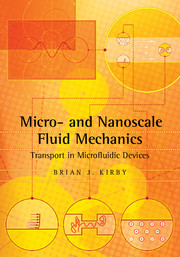Book contents
- Frontmatter
- Contents
- Preface
- Nomenclature
- Introduction
- 1 Kinematics, Conservation Equations, and Boundary Conditions for Incompressible Flow
- 2 Unidirectional Flow
- 3 Hydraulic Circuit Analysis
- 4 Passive Scalar Transport: Dispersion, Patterning, and Mixing
- 5 Electrostatics and Electrodynamics
- 6 Electroosmosis
- 7 Potential Fluid Flow
- 8 Stokes Flow
- 9 The Diffuse Structure of the Electrical Double Layer
- 10 Zeta Potential in Microchannels
- 11 Species and Charge Transport
- 12 Microchip Chemical Separations
- 13 Particle Electrophoresis
- 14 DNA Transport and Analysis
- 15 Nanofluidics: Fluid and Current Flow in Molecular-Scale and Thick-EDL Systems
- 16 AC Electrokinetics and the Dynamics of Diffuse Charge
- 17 Particle and Droplet Actuation: Dielectrophoresis, Magnetophoresis, and Digital Microfluidics
- APPENDIX A Units and Fundamental Constants
- APPENDIX B Properties of Electrolyte Solutions
- APPENDIX C Coordinate Systems and Vector Calculus
- APPENDIX D Governing Equation Reference
- APPENDIX E Nondimensionalization and Characteristic Parameters
- APPENDIX F Multipolar Solutions to the Laplace and Stokes Equations
- APPENDIX G Complex Functions
- APPENDIX H Interaction Potentials: Atomistic Modeling of Solvents and Solutes
- Bibliography
- Index
APPENDIX E - Nondimensionalization and Characteristic Parameters
Published online by Cambridge University Press: 05 June 2012
- Frontmatter
- Contents
- Preface
- Nomenclature
- Introduction
- 1 Kinematics, Conservation Equations, and Boundary Conditions for Incompressible Flow
- 2 Unidirectional Flow
- 3 Hydraulic Circuit Analysis
- 4 Passive Scalar Transport: Dispersion, Patterning, and Mixing
- 5 Electrostatics and Electrodynamics
- 6 Electroosmosis
- 7 Potential Fluid Flow
- 8 Stokes Flow
- 9 The Diffuse Structure of the Electrical Double Layer
- 10 Zeta Potential in Microchannels
- 11 Species and Charge Transport
- 12 Microchip Chemical Separations
- 13 Particle Electrophoresis
- 14 DNA Transport and Analysis
- 15 Nanofluidics: Fluid and Current Flow in Molecular-Scale and Thick-EDL Systems
- 16 AC Electrokinetics and the Dynamics of Diffuse Charge
- 17 Particle and Droplet Actuation: Dielectrophoresis, Magnetophoresis, and Digital Microfluidics
- APPENDIX A Units and Fundamental Constants
- APPENDIX B Properties of Electrolyte Solutions
- APPENDIX C Coordinate Systems and Vector Calculus
- APPENDIX D Governing Equation Reference
- APPENDIX E Nondimensionalization and Characteristic Parameters
- APPENDIX F Multipolar Solutions to the Laplace and Stokes Equations
- APPENDIX G Complex Functions
- APPENDIX H Interaction Potentials: Atomistic Modeling of Solvents and Solutes
- Bibliography
- Index
Summary
This appendix outlines the role of several key dimensional and nondimensional parameters in micro- and nanoscale fluid mechanics that come from nondimensionalization of governing equations. A key advantage of nondimensionalization is that it leads to a compact description of flow parameters (i.e., Re) and thus leads to generalization. Nondimensionalization can be a powerful tool, but it is useful only if implemented with insight into the physics of the problems. Our stress here is the process of nondimensionalization, rather than a listing of nondimensional parameters, and we focus on only a few examples.
BUCKINGHAM Π THEOREM
The Buckingham Π theorem is a theorem in dimensional analysis that quantifies how many nondimensional parameters are required for specifying a problem. It also provides a process by which these nondimensional parameters can be determined. The Buckingham Π theorem states that a system with n independent physical variables that are a function of m fundamental physical quantities can be written as a function of n – m nondimensional quantities. As an example, the steady Navier–Stokes equations have four parameters: a characteristic length ℓ, a characteristic velocity U, the viscosity η, and the fluid density ρ. These are a function of three fundamental physical quantities: mass, length, and time. Thus the system can be described in terms of 4 − 3 = 1 nondimensional quantity, and it can be shown that the nondimensional quantity must be proportional to ρUℓ/η to some power.
- Type
- Chapter
- Information
- Micro- and Nanoscale Fluid MechanicsTransport in Microfluidic Devices, pp. 440 - 449Publisher: Cambridge University PressPrint publication year: 2010



